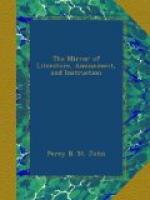temple at Memphis received numerous additions during
a long succession of ages. Some parts, both of
this temple and of the larger building at Carnak (sometimes
called a palace), have been constructed out of the
materials of earlier buildings, as we see from blocks
of stone being occasionally placed with inverted hieroglyphics.
It is impossible without good drawings and very long
descriptions, to give anything like an adequate idea
of the enormous remains of Carnak, among which we
find a hall whose roof of flat stones is sustained
by more than 130 pillars, some 26 feet, and others
as much as 34 feet, in circumference. The remains
on the western side of the river are, perhaps, more
interesting than those on the east. That nearly
all the monuments of Thebes belong to a period anterior
to the Persian conquest, B.C. 525, and that among
them we must look for the oldest and most genuine
specimens of Egyptian art, is clear, both from the
character of the monuments themselves and from historical
records; nor is this conviction weakened by finding
the name of Alexander twice on part of the buildings
at Carnak, which will prove no more than that a chamber
might have been added to the temple and inscribed with
his name; or that it was not unusual for the priests
to flatter conquerors or conquerors’ deputies
by carving on stone the name of their new master.
Thebes was the centre of Egyptian power and commerce,
probably long before Memphis grew into importance,
or before the Delta was made suitable to the purposes
of husbandry by the cutting of canals and the raising
of embankments.
[In a note to this passage, it is stated
that “Herodotus has given no description
of Thebes. Denon several times quotes Herodotus
for what is not in that author. But this is
so common, even with people who have claims to
scholarship, that it has become almost a fashion
to say that any thing is in Herodotus.”
So that the audience of Lord Goderich with the
late King, as described in the Edinburgh Review,
in the Herodotean (or says he and says she)
dialect, is no great license.]
[The volume is profusely embellished.]
* * * *
*
THE PUBLIC JOURNALS.
ERRORS OF THE DAY.
The devoutest believers in “the march of intellect”
must at intervals be almost driven to renounce their
creed in despair. Errors which were supposed
to have been exploded centuries ago, sometimes reappear
on a sudden, and propagate themselves for a season
with a rapidity which no reasoning can pursue, no
ridicule arrest. Notions, worthy only of the
dark ages, spring up in the glare of the supposed illumination
of the present day, and resist all the efforts of
the Briarean press itself to dispel them. At
one time, it is a pious Hungarian prince who performs
preternatural cures, at the request of the friends
of the sick parties in Ireland, conveyed through that




